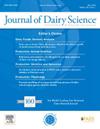奶牛胚胎移植后受孕率与人工授精后受孕率的比较。
IF 3.7
1区 农林科学
Q1 AGRICULTURE, DAIRY & ANIMAL SCIENCE
引用次数: 0
摘要
人工授精(AI)和胚胎移植(ET)对奶牛的繁殖非常重要。在选择合适的繁殖方法时,人工授精或胚胎移植后的受孕率是一项重要指标。然而,与人工授精相比,有关影响ET受孕率的环境因素的信息十分有限。我们旨在研究影响ET受孕率的环境因素,并确定人工授精与ET之间环境因素的差异。我们使用单独的多变量逻辑回归模型分析了日本北海道的荷斯坦无情母牛、初情母牛和多情母牛的首次人工授精记录(n = 1,870,143)和ET记录(n = 29,922)。对于每种繁殖方法,我们根据泌乳高峰期的产奶量(PY;初产牛<25、25-30、30-35、≥35 kg,多胎牛<40、40-45、45-50、≥50 kg)以及产犊到第一次人工授精或ET的间隔时间(CFI/CFT;<60、60-79、80-99、≥100 d)将初产牛和多胎牛分组,以评估PY和CFI/CFT对受胎率的影响。初产和多产奶牛的人工授精受胎率随着泌乳量的增加而降低,而ET受胎率没有显著降低。此外,即使初产母牛和多胎母牛在CFI/CFT中的受胎率略早于60 d,与60 d后的CFI/CFT相比,ET受胎率也没有下降,这与AI受胎率不同。总之,通过ET配种可避免高产奶量和产犊对受胎率的负面影响,表明奶牛在产犊后60 d内可通过ET受孕。本文章由计算机程序翻译,如有差异,请以英文原文为准。
Characterization of conception rate after embryo transfer in comparison with that after artificial insemination in dairy cattle
Artificial insemination and embryo transfer (ET) are important in the reproduction of dairy cows. The conception rate after AI or ET is an essential indicator when selecting appropriate breeding methods. However, information on the environmental factors affecting ET conception rate when compared with AI is limited. We aimed to investigate environmental factors affecting ET conception rate and characterize the differences in environmental factors between AI and ET. Records of the first AI (n = 1,870,143) and ET (n = 29,922) from Holstein nulliparous, primiparous, and multiparous cows in Hokkaido, Japan, were analyzed using separate multivariable logistic regression models. For each breeding method, we grouped primiparous and multiparous cows according to milk yield at peak lactation (PY; <25, 25–30, 30–35, or ≥35 kg in primiparous; <40, 40–45, 45–50, or ≥50 kg in multiparous) and the interval from calving to first AI or to first ET (CFI and CFT, respectively; <60, 60–79, 80–99, or ≥100 d) to evaluate the effects of PY and CFI or CFT on conception rate. The AI conception rate decreased with increasing PY in primiparous and multiparous cows, whereas ET conception rate did not decrease significantly. Additionally, the ET conception rate did not decrease even in primiparous and multiparous cows slightly earlier than 60 d in CFI/CFT compared with those in CFI/CFT after 60 d, which differed from the AI conception rate. Collectively, breeding by ET leads to the avoidance of negative effects of high milk yield and calving on the conception rate, indicating that cows are fertile by ET within 60 d after calving.
求助全文
通过发布文献求助,成功后即可免费获取论文全文。
去求助
来源期刊

Journal of Dairy Science
农林科学-奶制品与动物科学
CiteScore
7.90
自引率
17.10%
发文量
784
审稿时长
4.2 months
期刊介绍:
The official journal of the American Dairy Science Association®, Journal of Dairy Science® (JDS) is the leading peer-reviewed general dairy research journal in the world. JDS readers represent education, industry, and government agencies in more than 70 countries with interests in biochemistry, breeding, economics, engineering, environment, food science, genetics, microbiology, nutrition, pathology, physiology, processing, public health, quality assurance, and sanitation.
 求助内容:
求助内容: 应助结果提醒方式:
应助结果提醒方式:


